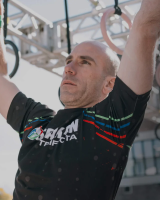Spartan Obstacle Master Class: Wall Climbs

Climbing Wall: The Spartan Race Wall Climb
The Wall Climb obstacle is just as you imagine it is: It's a climbing wall set-up that is part of a Spartan Race.
What It Entails
A wall 4-foot, 6-foot or 8-foot high wall that you must climb over and down the other side.
What You Need
What are the athletic capacities that come into play with the being proficient with a climbing wall? Agility, coordination, upper body pulling strength, hip flexibility and upper body general strength. (This will get you there.)
Mistakes I Most Often See
At a race it often looks like it is the first time many people have actually tried to climb a wall. Many lack the upper body pulling strength needed to make it over easily. Second to that I notice most do not have a plan or the proper technique to climb down the wall safely or in a way that will reduce injury. Lastly the mistake I see is overconfidence or rushing to get through the obstacle.
Prepare to dominate the course. Download the Spartan Obstacle Guide
Climbing Up
To be safe climbing a wall that is covered in mud and water you need to start in a safe clean environment. Climbing a wall is a whole body task that requires upper body pulling, lower body pushing, and coordination.
Start with a small climbing wall if possible learn how to vault over the 4-foot wall. Practice laying on top of the wall. Figure out if you are right or left side dominant.
Which way are you comfortable facing when on top of the wall?
When you get to the larger wall do you reach up with your left or right? This might look similar to a lay up shot in basketball. Which hand reaches for the basket? That is your dominant hand that you will use to grab the wall.
Which foot do you push off? That will be the foot you place on the wall first.
Practice hanging on the wall and pulling. Can you pull your body up? A little or a lot? If a get little to no movement you will need to focus on proper technique and foot placement. If you can do a full pull up on the wall you may be able to use a more advanced technique called the muscle up.
Work first on trying to “walk” up the wall and “hooking” your heel or leg over the top and using your arms and leg to pull you on top of the wall. If your feet slide down when you attempt this your hips might be either too close to the wall or too far above your feet. Make sure when you walk up the wall that you can “push” your feet into the wall. Sometimes athletes pull too early with their arms and change their center of gravity from going “into” the wall to going towards the ground. This is when the feet slip down the wall making the heel or leg hook difficult.
Over the Top and Down
When going over the top of the wall be careful to not kick anyone with your feet or legs.
To go down, sit or rest on the top by laying down on your chest. Survey the other side of the wall. Every injury I have seen at the wall has been dismounting too quickly or landing on uneven terrain. I like to “brake” on my way down the other side.
This is done by swinging just your legs over while resting your hip or waist on top of the wall. Plant your hands and put your feet into the wall. When you push off/lower yourself down the wall push your heels into the wall and sit down while still holding onto the wall. Once your arms are extended lower your feet and land softly.
Additional Thoughts
Always make sure that the path is clear: Do not run/rush past someone to make it over the wall faster unless you are in a competitive heat. Even then it’s not a good move.
Always check the landing area to make sure it’s clear of debris. Sometimes water hides rocks.
Landing wrong will cost you the whole race.
When teammates are trying to help you over the wall I advocate the “chair” method instead of the “five finger” method. The chair method is stable and much safer. This technique is when a teammate sits with their back against the wall and the athlete “steps” up then to climb over the wall.
This is part of a series of obstacle tips articles by Spartan SGX Level 2 Coach Rich Borgatti. Be sure to check out his advice on the Barbed-Wire Crawl, Z-Wall Traverse, the Spear Throw and the Bucket Carry.











